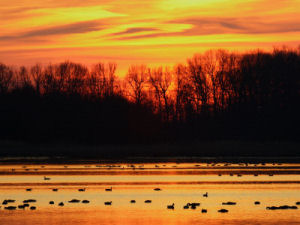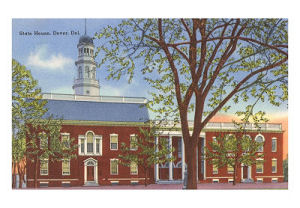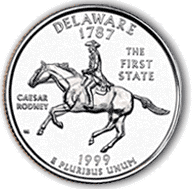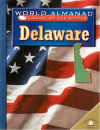
HOME
INTRO
SYMBOLS
ALMANAC
ECONOMY
GEOGRAPHY
STATE MAPS
PEOPLE
FORUM
NEWS
COOL SCHOOLS
STATE QUIZ
STATE LINKS
BOOK STORE
MARKETPLACE
GUESTBOOK
CONTACT US


The State of Delaware

Bombay Hook National Wildlife Refuge
On December 7, 1787, Delaware, became the first state to ratify the United States Constitution. Before that, it was the only colony to be claimed by Sweden, Holland and England. And before that, there is some evidence that Egyptian explorers found their way to the state.
The log cabin was introduced by the Swedes. The first regularly operated steam railroad began operations in New Castle in 1831.
Today, Delaware has become a farming and industrial state. At one time the center of this country's flour industry, it is today the leading producer of chemicals in the United States and, because of its corporate laws, more corporations are headquartered in Delaware than in any other state.
THE STATE NAME:
One name goes a long way in this small state. The Indians and the state were both named after the Delaware River. And where did the river get its name? The Delaware River was named after Sir Thomas West (Lord de la Warr), the Virginia Company's first governor.
THE STATE NICKNAMES:

The Old State House, Dover
The First State (Official)
Delaware was the first state to ratify the United States Constitution in 1787. There is only one First State and Delaware is it.
"The First State" became the official State nickname on May 23, 2002 following a request by Mrs. Anabelle O'Malley's First Grade Class at Mt. Pleasant Elementary School.
The Diamond State
This nickname for Delaware is echoed in the State Flag. The buff colored diamond serves as a frame for the state Coat of Arms. This nickname originated with Thomas Jefferson who compared Delaware to a diamond; small but very valuable. According to the Delaware Government Information Center, Thomas Jefferson described Delaware as "...a 'jewel' among states due to its strategic location on the Eastern Seaboard."
The Blue Hen State
This historical nickname, sometimes Blue Hen Chicken State, originated during the Revolutionary War. According to W.A. Powell's History of Delaware, 1928, the story traces back to a Captain Caldwell from Kent County who carried with him a pair of fighting game cocks. These chickens, descendents of a famous Blue Hen, were well known in Kent County for their superior fighting qualities. It is said that upon seeing these game cocks fight, one soldier cried "We're sons of the Old Blue Hen and we're game to the end" comparing the fighting prowess of the chickens to the fighting prowess of the Delaware soldiers. These regiments from Kent County became known as "Blue Hen's Chickens." This name was soon applied state wide. In 1939, the Blue Hen Chicken was adopted as Delaware's official State Bird.
The Peach State
In the 1500s, the Spanish brought peaches to Delaware. By the 1600s, peaches were so plentiful in the state that farmers used them to feed their pigs. Supported by the Delaware Railroad in the early nineteenth century, Delaware became the leading producer of peaches in the United States. Almost 6,000,000 baskets of peaches were shipped to market in 1875, Delaware's peak production year. Many problems beset peach farmers throughout the latter part of the century. The peach blight, called the "yellows" forced the collapse of the industry and, in the early 1900s, many peach farmers faced bankruptcy.
The Corporate Capital
Delaware has been called the "Corporate Capital" because so many corporations have incorporated in the state because of its business-friendly law. According to the Delaware Division of Corporations (2002), more than 308,000 companies are incorporated in Delaware. This includes 60% of the Fortune 500 and 50% of the companies listed on the New York Stock Exchange.
Small Wonder
A new nickname developed to promote the state's contributions to the nation and its natural beauty.
New Sweden
Refers to the first permanent settlement in Delaware in the present day Wilmington. Delaware was under Swedish rule from 1638 to 1655. The first Swedish settlement was at "The Rocks," on the Christina River, near the foot of Seventh Street. The Christina River was named after the young queen of Sweden as was the fort that was built.
Uncle Sam's Pocket Handkerchief
This obscure nickname probably refers to the small size of Delaware.
Other
Delaware has also been called "The Chemical Capital" and the "Home of Tax Free Shopping."
THE STATE CITIZENS:
People who live in Delaware or who come from Delaware are referred to as Delawareans.
Nicknames have included "Blue Hen's Chickens," as mentioned above. Delawareans were also called "Muskrats" because of the large number of muskrats present in the early days of the state. It was humorously asserted that because of the small area of Delaware, only muskrats could get a foothold in the state.
THE STATE QUARTER:

United States Mint Image
The first state to ratify the United States Constitution was also the first state to have its own commemorative state quarter minted. This quarter, minted in 1999, depicts Caesar Rodney, in 1776, braving thunderstorms and a severe summer heat wave on his way to Philadelphia to cast the deciding vote for the independence of the British colonies.
For more about the state commemorative quarters, visit this page.
This 50 State Quarter Map is a great way to collect and display all 50 State Quarters.
Sources...
Government Information Center, The State of Delaware. 26 June 2009. Delaware Facts
Carpenter, Allan & Provose, Carl. The World Almanac® of the U.S.A.. World Almanac Books (An Imprint of K-III Reference Corporation, A K-III Communications Company). Mahwah, N.J., 1996.
Shankle, George Earlie. State Names, Flags, Seals, Songs, Birds, Flowers, and Other Symbols. Irvine, Calif.: Reprint Services Corp, Revised edition, 1971.
Shearer, Benjamin F. and Barbara S. State Names, Seals, Flags and Symbols: A Historical Guide Third Edition, Revised and Expanded. Westport, Conn: Greenwood Press, 3 Sub edition, 2001.
Additional information

Delaware
Amy Miller
Delaware (From Sea to Shining Sea), by Amy Miller. 80 pages. Publisher: Scholastic Library Publishing (September 2002) Reading level: Grades 3-5. Presents information about Delaware's people, geography, history, landmarks, natural resources, government, state capitol, towns and cities, and more.

Delaware
Justine & Ron Fontes
Delaware (World Almanac Library of the States), by Justine & Ron Fontes. 48 pages. Gareth Stevens Publishing (February 2003) Reading level: Grades 4-6. Filled with the most up-to-date information, including the latest Census results. Full-color photos bring to life the story of Delaware. In addition to an in-depth factual profile of Delaware in the form of a state Almanac, this book offers fascinating and lively discussions of the state's history, people, geography, government, economy, culture, and lifestyles. A section on Notable People, a calendar of events, and enough primary source documents, time lines, maps, and other tools to make this unquestionably the best young adult reference material on the USA available anywhere.

History of Delaware
John A. Monroe
History of Delaware, by John A. Monroe. 304 pages. University of Delaware Press; 5th edition (April 30, 2006) Originally undertaken by the author as a Bicentennial project in 1975, and now the standard history of the state, this volume chronicles the history of Delaware from the early 1600s to the present.
John A. Munroe was H. Rodney Sharp Professor of History at the University of Delaware.
| Do you know... |



